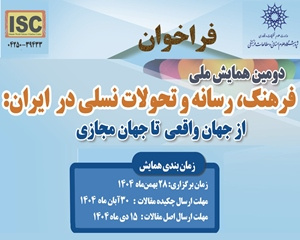پیش بینی نوموفوبیا بر اساس سبک های دلبستگی با نقش واسطه ای احساس تنهایی در نوجوانان (مقاله علمی وزارت علوم)
درجه علمی: نشریه علمی (وزارت علوم)
منبع:
خانواده درمانی کاربردی دوره 4 ویژه نامه 1402 شماره 3 (پیاپی 17) مجموعه مقالات حوزه خانواده و فرزند
حوزههای تخصصی:
شماره صفحات:
۱۲۵ - ۱۴۴
دریافت مقاله
تعداد دانلود :
۳۸۸
آرشیو
چکیده
هدف: پژوهش حاضر با هدف پیش بینی نوموفوبیا بر اساس سبک های دلبستگی با نقش واسطه ای احساس تنهایی در نوجوانان انجام گرفت. روش پژوهش: این طرح پژوهش همبستگی و از نوع مدل یابی معادلات ساختاری بود. نمونه پژوهش متشکل از 500 نفر از دانش آموزان شاغل به تحصیل در دوره متوسطه دوم در سال تحصیلی 1400-1399 بود که با روش نمونه گیری در دسترس بصورت آنلاین انتخاب شدند. برای اندازه گیری متغیرهای پژوهش از پرسشنامه نوموفوبیا یلدریم و کوریا (2015)، مقیاس دلبستگی بزرگسالان کولینز و رید (۱۹۹۰) و مقیاس احساس تنهایی دیتوماسو و همکاران (2004) استفاده شد. داده ها با ضریب همبستگی پیرسون و مدل معادلات ساختاری تحلیل شدند. یافته ها: یافته ها نشان داد مسیرهای مستقیم این پژوهش سبک های دلبستگی اجتنابی و دوسوگرا به جز سبک دلبستگی ایمن ادراک شده بر نوموفوبیا معنادار شدند. همچنین نتایج تحلیل عامل تاییدی اصلاح شده نشان می دهد (001/0=P، 626/0 =F) همچنین نتایج حاکی از برازش خوب مدل اندازه گیری با داده هاست؛ و تمامی متغیرهای مشاهده شده دارای بار عاملی بالاتر از 3/0 بودند. در بخش دیگر نتایج مربوط به مسیرهای مستقیم، سبک های دلبستگی بر احساس تنهایی معنادار شدند. همچنین تمامی مسیرهای غیرمستقیم سبک های دلبستگی از طریق نقش واسطه ای احساس تنهایی بر نوموفوبیا معنادار بود. همچنین یافته ها نشان می دهد سبک های دلبستگی و احساس تنهایی می توانند 54 درصد از تغییرات نوموفوبیا را پیش بینی می کند ضریب تعیین متغیر احساس تنهایی برابر 38 درصد در حد متوسط تا قوی می باشد. نتیجه گیری: لذا متغییر های سبک های دلبستگی ادراک شده پیش بینی کننده های نوموفوبیا در نوجوانان می باشندPrediction of nomophobia based on attachment styles with the mediating role of loneliness in adolescents
Aim: The present study was conducted with the aim of predicting nomophobia based on attachment styles with the mediating role of loneliness in adolescents. Methods: This research design was correlational and structural equation modeling. The research sample consisted of 500 working students studying in the second secondary course in the academic year 2020-2021, who were selected by online sampling method. Yıldırım and Correa's Nomophobia Questionnaire (2015), Collins and Reid's Adult Attachment Scale (1990) and DiTomaso et al.'s (2004) Loneliness Scale were used to measure the research variables. Data were analyzed with Pearson correlation coefficient and structural equation model. Results: The findings showed that the direct paths of this research of avoidant and ambivalent attachment styles were significant except for the perceived secure attachment style on nomophobia. Also, the results of the modified confirmatory factor analysis show (P = 0.001, F = 0.626) and the results indicate a good fit of the measurement model with the data; and all observed variables had a factor load higher than 0.3. In the other part of the results related to the direct paths, attachment styles were significant on the feeling of loneliness. Also, all the indirect paths of attachment styles through the mediating role of loneliness on nomophobia were significant. Also, the findings show that attachment styles and feelings of loneliness can predict 54% of the changes in nomophobia. The coefficient of determination of the variable feeling of loneliness is equal to 38% in the moderate to strong range. Conclusion: Therefore, variables of perceived attachment styles are predictors of nomophobia in adolescents






